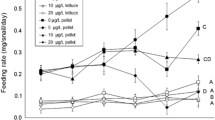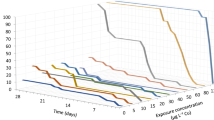Abstract
Florida apple snails (Pomacea paludosa) were exposed to three concentrations of copper (Cu), in water (8 μg/L, 16 μg/L, 24 μg/L), for one generation to examine uptake and the effects on survival, growth, and reproduction of the F0 generation and survival, growth, and whole body Cu of the F1 generation. During a 9-month Cu exposure, apple snails exposed to 8–16 μg/L Cu had high Cu accumulation (whole body, foot, viscera, and shell) and significantly reduced clutch production (8–16 μg/L) and egg hatching (16 μg/L). Apple snails exposed to the 24 μg/L Cu had low survival and the treatment was therefore terminated. Concentrations of minerals (Na+, K+, Mg2+, Ca2+) in tissues were maintained regardless of Cu exposure, but the distribution of Cu in the body of snails differed, depending on exposure concentrations. Higher exposure concentrations resulted in a greater percentage of Cu accumulated in the viscera of the snail. Copper exposure to the F0 generation did not affect the survival, growth, or whole body Cu concentrations in the F1 generation. These finding are significant, given the importance of the Florida apple snail in the Everglades food chain. Changes in the abundance of apple snail populations, as a result of Cu exposure, could ultimately affect foraging success of predators.


Similar content being viewed by others
References
Alva AK, Graham JH, Anderson CA (1995) Soil-pH and copper effects on young Hamlin orange trees. J Soil Sci Soc Am 59:481–487
Bossuyt BTA, Janssen CR (2003) Acclimation of Daphnia magna to environmentally realistic copper concentrations. Comp Biochem Phys C: Toxicol Pharmacol 136(3):253–264. doi:10.1016/j.cca.2003.09.007
Boulding EG, Hay TK (1993) Quantitative genetics of shell form of an intertidal snail-constraints on short-term response to selection. Evolution 47:576–592. doi:10.1016/0022-2011(77)90179-3
Cheng TC (1979) Use of copper as a molluscicide. Copper in the environment, Part 2. Nriagu, Wiley, New York
Cheng TC, Sullivan JT (1977) Alterations in the osmoregulation of the pulmonate gastropod Biomphalaria glabrata due to copper. J Invert Pathol 29(1):101–104
Corrao NM, Darby PC, Pomory CM (2006) Nitrate impacts on the Florida apple snail, Pomacea paludosa. Hydrobiologia 568:135–143. doi:10.1007/s10750-006-0199-8
De Lara AV (1988) Life history of golden apple snail (Pomacea canaliculata) under laboratory conditions. Terminal report. Institute of Biological Sciences, University of the Philippines Los Baños, Laguna
Depledge MH, Rainbow PS (1990) Models of regulation and accumulation of trace metals in marine invertebrates. Comp Biochem Phys C: Toxicol Pharmacol 97C(1):1–7. doi:10.1016/0742-8413(90)90163-4
DeSchamphelaere KAC, Forrez I, Dierckens K, Sorgeloos P, Janssen CR (2007) Chronic toxicity of dietary copper to Daphnia magna. Aquat Toxicol 81(4):409–418. doi:10.1016/j.aquatox.2007.01.002
Desouky MMA (2006) Tissue distribution and subcellular localization of trace metals in the pond snail Lymnaea stagnalis with special reference to the role of lysosomal granules in metal sequestration. Aquat Toxicol 77:143–152. doi:10.1016/j.aquatox.2005.11.009
Erickson RJ, Benoit DA, Mattson VR, Nelson HP, Leonard EN (1996) The effects of water chemistry on the toxicity of copper to fathead minnows. Environ Toxicol Chem 15:181–193. doi:10.1897/1551-5028(1996)015<0181:TEOWCO>2.3.CO;2
Frakes RA, Bargar TA, Boughner EA (2008) Sediment copper bioavailability to freshwater snails in South Florida: risk implications for the Everglade snail kite (Rostrhamus sociabilis plumbeus). Ecotoxicology doi:10.1007/s10646-008-0233-x
Gomot-de Vaufleury A, Pihan F (2002) Methods for toxicity assessment of contaminated soil by oral or dermal uptake in land snails: metal bioavailability and bioaccumulation. Environ Toxicol Chem 21:820–827. doi:10.1897/1551-5028(2002)021<0820:MFTAOC>2.0.CO;2
Hanning GW (1979) Aspects of reproduction in Pomacea paludosa. MS thesis, Florida State University, Tallahassee
Hoang TC, Rogevich EC, Rand GM, Gardinali PR, Frakes RA, Bargar TA (2008a) Copper desorption in flooded agricultural soils and toxicity to the Florida apple snail (Pomacea paludosa): implications in Everglades restoration. Environ Pollut 154(2):338–347. doi:10.1016/j.envpol.2007.09.024
Hoang TC, Rogevich EC, Rand GM (2008b) Copper uptake and depuration by juvenile and adult Florida apple snails (Pomacea paludosa). Ecotoxicology doi 10.1007/s10646-008-0243-8
Howarth RS, Sprague JB (1978) Copper lethality to rainbow trout in waters of various hardness and pH. Water Res 12:455–462. doi:10.1016/0043-1354(78)90152-5
Koivisto S, Ketola M, Walls M (1992) Comparison of five cladoceran species in short- and long-term copper exposure. Hydrobiologia 248(22):125–136. doi:10.1007/BF00006080
Lam IKS, Wang W (2006) Transgenerational retention and maternal transfer of selenium in Daphnia magna. Environ Toxicol Chem 25(9):2519–2525. doi:10.1897/05-631R.1
Laskowski R, Hopkin SP (1996) Accumulation of Zn, Cu, Pb and Cd in the garden snail (Helix aspersa): implications for predators. Environ Pollut 91:289–297. doi:10.1016/0269-7491(95)00070-4
Lauren DJ, McDonald DG (1985) Effects of copper on branchial ionoregulation in the rainbow trout, Salmo gairdneri. J Comp Phys B 155:635–644. doi:10.1007/BF00694455
Lauren DJ, McDonald DG (1987) Acclimation to copper by rainbow trout, Salmo gairdneri: physiology. J Can Fish Aquat Sci 44(1):99–104. doi:10.1139/f87-012
Marr JCA, Lipton J, Cacel D et al (1996) Relationship between copper exposure duration, tissue copper concentration, and rainbow trout growth. Aquat Toxicol 36(1–2):17–30. doi:10.1016/S0166-445X(96)00801-6
Martin TW, Doebel JH (1973) Management techniques for the Everglade kite: preliminary report. In Proceedings of the 27th Annual Conference of the Southeastern Association of Game and Fish Commissioners 27:225–236
Mason AZ, Nott JA (1981) The role of intracellular biomineralized granules in the regulation and detoxification of metals in gastropods with special reference to the marine prosobranch Littorina littorea collected from clean and polluted sites. J Marine Biol Assoc UK 64:699–720
McKim JM, Benoit DA (1971) Effects of long-term exposures to copper on survival, growth, and reproduction of brook trout (Salvelinus fontinalis). J Fish Res Board Can 28(55):655–662
Miller TG, Mackay WC (1980) The effects of hardness, alkalinity and pH of test water on the toxicity of copper to rainbow trout (Salmo gairdneri). Water Res 14:129–133. doi:10.1016/0043-1354(80)90228-6
Pagenkopf GK (1983) Gill surface interaction model for trace-metal toxicity to fishes: role of complexation, pH, and water hardness. Environ Sci Technol 17:342–347. doi:10.1021/es00112a007
Peña SC, Pocsidio GN (2007) Influence of copper on the feeding rate, growth and reproduction of the Golden apple snail, Pomacea canaliculata Lamarck. Bull Environ Contam Toxicol 79(6):606–608. doi:10.1007/s00128-007-9312-6
Phillips DJH, Rainbow PS (1989) Strategies of trace metal sequestration in aquatic organisms. Marine Environ Res 28:207–210. doi:10.1016/0141-1136(89)90226-2
Real M, Munoz I, Guasch H, Navarro E, Sabater S (2003) The effect of copper exposure on a simple aquatic food chain. Aquat Toxicol 63:283–291. doi:10.1007/s00244-007-9106-1
Rogevich EC, Hoang TH, Rand GM (2008) The effects of water quality and age on the acute toxicity of copper to the Florida apple snail, Pomacea paludosa. Arch Environ Contam Toxicol 54(4):690–696
Santore RC, DiToro DM, Paquin PR, Allen HE, Meyer JS (2001) Biotic ligand model of the acute toxicity of metals. 2. Application to acute copper toxicity in freshwater fish and Daphnia. Environ Toxicol Chem 20(10):2397–2402. doi:10.1897/1551-5028(2001)020<2397:BLMOTA>2.0.CO;2
Schuler LJ, Hoang TC, Rand GM (2008). Aquatic risk assessment of copper in freshwater and saltwater ecosystems of south Florida. Ecotoxicology doi 10.1007/s10646-008-0236-7
Sharfstein B, Steinman AD (2001) Growth and survival of the Florida apple snail (Pomacea paludosa) fed 3 naturally occurring macrophyte assemblages. J North Am Bethol Soc 20(1):84–95. doi:10.2307/1468190
Simkiss K (1981) Cellular discrimination processes in metal accumulating cells. J Exp Biol 94:317–327
Soto M, Cajaraville MP, Marigómez I (1996) Tissue and cell distribution of copper, zinc and cadmium in the mussel, Mytilus galloprovincialis, determined by autometallography. Tissue Cell 28(5):557–568. doi:10.1016/S0040-8166(96)80058-9
Taylor HH, Anstiss JM (1999) Copper and haemocyanin dynamics in aquatic invertebrates. Marine Freshwater Res 50(8):907–931. doi:10.1071/MF99117
Tsui MKT, Wang WX (2004) Maternal transfer efficiency and transgenerational toxicity of methylmercury in Daphnia magna. Environ Toxicol Chem 23(6):1504–1511. doi:10.1897/03-310
Turner RL, McCabe CM (1990) Calcium source for protoconch formation in the Florida apple snail, Pomacea paludosa (Prosobranchia: Pilidae): more evidence for physiologic plasticity in the evolution of terrestrial eggs. Veliger 33:185–189
US Department of the Interior (2001–2005) Everglades National Park Strategic Plan. National Parks Service, US Department of the Interior, Homestead, FL
US Environmental Protection Agency (1996a) Office of Prevention, Pesticides and Toxic Substances. Harmonized Test Guidelines Series 850. Ecological Effects. 850.1500 Fish Life Cycle Toxicity. US Environmental Protection Agency, Washington, DC
US Environmental Protection Agency (1996b) Acid digestion of sediment, sludges and soils: EPA method 3050B SW-846 manual. US Environmental Protection Agency, Washington, DC
Viarengo A (1989) Heavy metals in marine invertebrates: mechanisms of regulation and toxicity at the cellular level. CRC Rev Aquat Sci 1:95–317
Acknowledgments
We thank Robert Frakes of the US Fish and Wildlife Service, Pamela Bachman (FIU), and Kathy Moore (Clemson University) for their assistance with completing this study. We thank Philip Darby of the University of West Florida for technical support on the Florida apple snail. This is SERC contribution No. 403.
Author information
Authors and Affiliations
Corresponding author
Rights and permissions
About this article
Cite this article
Rogevich, E.C., Hoang, T.C. & Rand, G.M. Effects of Sublethal Chronic Copper Exposure on the Growth and Reproductive Success of the Florida Apple Snail (Pomacea paludosa). Arch Environ Contam Toxicol 56, 450–458 (2009). https://doi.org/10.1007/s00244-008-9231-5
Received:
Accepted:
Published:
Issue Date:
DOI: https://doi.org/10.1007/s00244-008-9231-5




